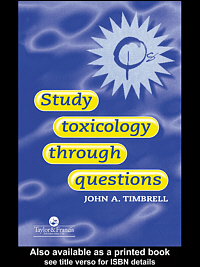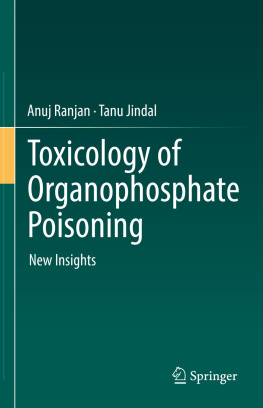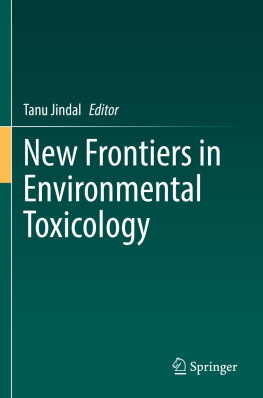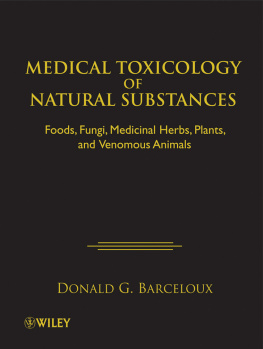Cover

| title | : | Study Toxicology Through Questions |
| author | : | Timbrell, John A. |
| publisher | : | Taylor & Francis Routledge |
| isbn10 | asin | : |
| print isbn13 | : | 9780203484012 |
| ebook isbn13 | : | 9780585461502 |
| language | : | English |
| subject | Toxicology--Examinations, questions, etc. |
| publication date | : | 1997 |
| lcc | : | RA1216.T56 1997eb |
| ddc | : | 615.9/0076 |
| subject | : | Toxicology--Examinations, questions, etc. |
Page i
Study toxicology through questions
Page ii
This page intentionally left blank.
Page iii
Study toxicology through questions
John A.Timbrell
Glaxo Professor of Toxicology
School of Pharmacy
University of London

Page iv
UK Taylor & Francis Ltd., 1 Gunpowder Square, London EC4A 3DE
USA Taylor & Francis Inc., 1900 Frost Road, Suite 101, Bristol, PA 19007
This edition published in the Taylor & Francis e-Library, 2003.
Copyright John A.Timbrell 1997
All rights reserved. No part of this publication may be reproduced, stored
in a retrieval system, or transmitted, in any form or by any
means, electronic, electrostatic, magnetic tape, mechanical, photocopying,
recording or otherwise, without the prior permission of the copyright
owner.
British Library Cataloguing in Publication Data
A catalogue record for this book is available from the British Library.
ISBN 0-203-48401-0 Master e-book ISBN
ISBN 0-203-22793-X (OEB Format)
ISBN 0-7484-0695-6 (Print Edition)
Library of Congress Cataloguing Publication Data are available
Cover design by Amanda Barragry
Page v
Contents
Preface | |
Introduction | |
| General toxicology | |
Multiple choice questions | |
Short answer questions | |
Answers | |
Multiple choice | |
Short answers | |
| Absorption, distribution and excretion of compounds | |
Multiple choice questions | |
Short answer questions | |
Problem solving questions | |
Answers | |
Multiple choice | |
Short answers | |
Problem solving | |
| Metabolism of compounds | |
Page vi
Multiple choice questions | |
Short answer questions | |
Problem solving questions | |
Answers | |
Multiple choice | |
Short answers | |
Problem solving | |
| Factors affecting the toxicity of compounds | |
Multiple choice questions | |
Short answer questions | |
Problem solving questions | |
Answers | |
Multiple choice | |
Short answers | |
Problem solving | |
| Toxic responses | |
Multiple choice questions | |
Short answer questions | |
Problem solving questions | |
Answers | |
Multiple choice | |
Short answers | |
Problem solving | |
| Mechanisms of toxicity | |
Multiple choice questions | |
Problem solving questions | |
Answers | |
Multiple choice | |
Problem solving | |
| Overall integration of the subject | |
Problem solving questions | |
Answers | |
Problem solving | |
Page 1
Preface
This book has arisen from my involvement in teaching a BSc course in Toxicology and Pharmacology over the last 16 years. After devising questions of various types over this time I discovered how difficult and time consuming this can be. To refine the questions and put them together into a book with suggested answers seemed a useful endpoint which could be used by toxicologists at all levels.
I wish to thank Andy Shaw for his pharmacokinetics questions and Elaine Stott at Taylor & Francis for her help. However, I am especially grateful to Cathy Waterfield for producing all the figures and setting up the manuscript as camera ready copy, as well as for her patience.
London, April 1997.
Page 2
This page intentionally left blank.
Page 3
Introduction
This book is intended for several types of audience:
The student who needs a study aid for toxicology but wants more than a textbook as they need a self-testing regime. |
The teacher of toxicology who needs inspiration when composing questions for their students. |
The established toxicologist who wants to test their own knowledge or understanding. |
It can be used at universities and colleges but also in industry for in-house training courses in toxicology which I know exist in some pharmaceutical and chemical companies.
The questions are a mixture of multiple choice, short answer and problem solving questions and are not meant to reflect a particular level of knowledge or development. Consequently some of the answers may be short whereas others are quite lengthy, even in the same question. are
Although based loosely on Principles of Biochemical Toxicology, this book can be used alongside a number of standard toxicology texts which are listed below.
Suggested reading
Next page






